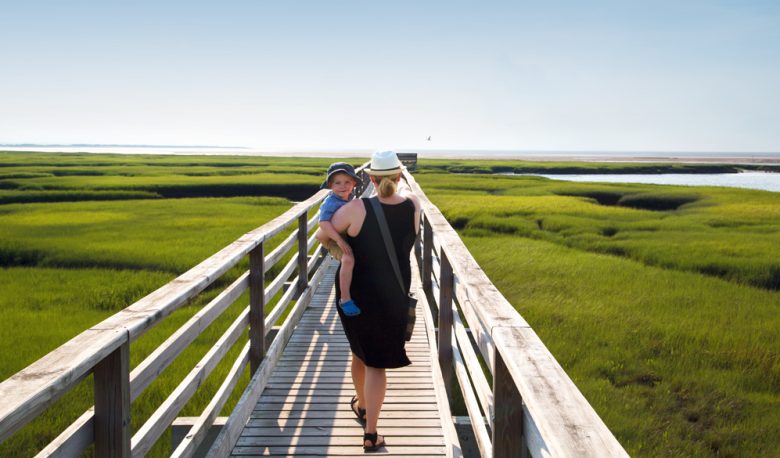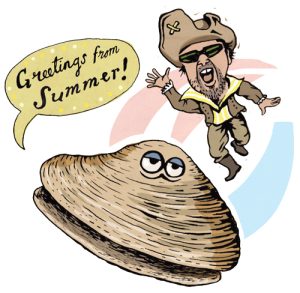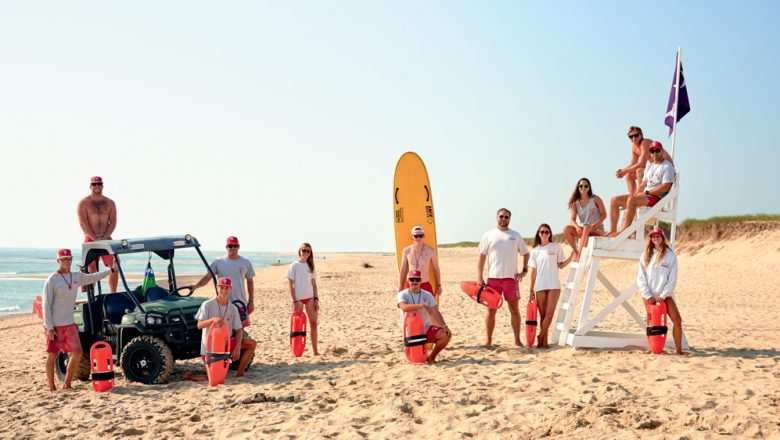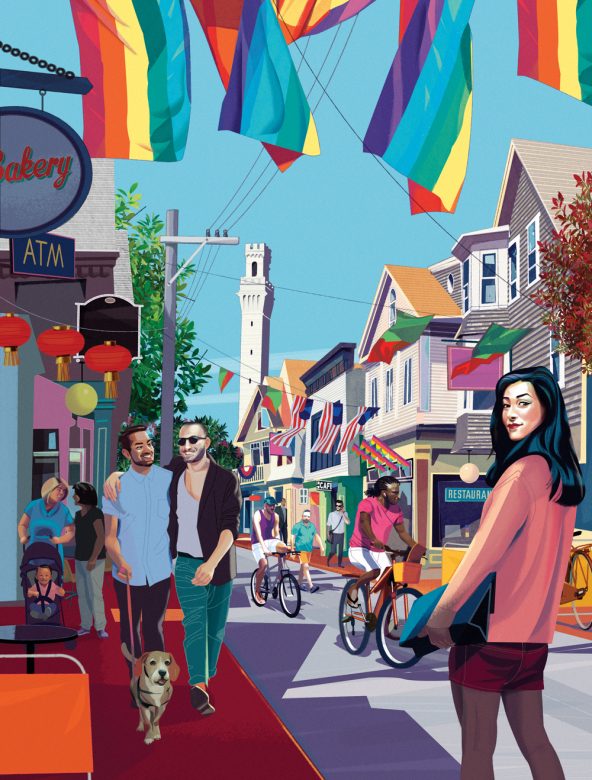13 Reasons Why We Love Cape Cod: Everything Else
World-class lifeguards, people-watching in P-town, community radio, a classic summer cocktail, and more.

Bass Hole Boardwalk, Gray’s Beach. Yarmouth Port.
Photo Credit : David TrifilettiEven More Reasons to Love Cape Cod

Photo Credit : David Trifiletti
You Can Walk on Water
The many boardwalks across the Cape protect the fragile wetland places—the shallows, salt marshes, and bogs. And taking a stroll on one can feel miraculous: the teeming ecosystem beneath your feet, the shorebirds preening nearby, the wide-open view…
———
The Cape Cod National Seashore
Created on August 7, 1961, with JFK’s presidential pen stroke, this 43,600-acre national park gave everyone access to one of the most treasured stretches of coastline in the East—and in doing so, helped save it. Read the whole story here.
———
It Rewards Wandering
Puzzling out directions on Cape Cod isn’t easy: To go “down Cape,” you travel north toward Provincetown; to go “up Cape,” you head south and west toward Bourne and Falmouth. So keep a map handy, but be open to serendipity. The Cape’s 400 square miles are packed with summer hot spots—some of which you might discover only by letting yourself get lost.

Photo Credit : Illustration by John S. Dykes
———
You Can Tell Time Like a Mariner
The clock at the First Congregational Church in Wellfleet is the only town clock in the world that strikes ship’s time. Listen for the chimes every 30 minutes: twice at the top of the hour, once at the half hour.
———
It’s Easy to Tune In to the Community
Home to such local-interest programs as Fishing News and The Weekly Bird Report, award-winning public radio station WCAI gets hyperlocal with the supershort audio clips it sprinkles throughout the day. With titles like “Scalloper,” “Bakesale,” and “Dogs and Boats,” these so-called sonic IDs typically feature someone talking about a uniquely local phenomenon—or as WCAI puts it, “little fragments of life as lived by our neighbors.”
———

Photo Credit : Adam DeTour
The Cape Codder
In the beginning there was the Rangoon Ruby, which begat the Bog Fog. Never mind that they were precisely the same: vodka, cranberry, squeeze of lime. Cocktails are fickle like that—they exist for a time, and then someone anoints them with a new name.
So, sometime in the 1960s, the drink got yet another name: the Cape Codder. This was in part due to savvy marketing by Ocean Spray, which was looking to encourage cranberry consumption on days that didn’t begin with “thanks” and end with “giving.”
But it was also a drink for the times. Vodka was ascendant, and the Cape Codder was a simple and tasty way to mix it. It became a hallowed standard of bars everywhere—especially on Cape Cod, possibly because the drink was as elemental as the Cape, which itself has three key ingredients: sand, sky, and sea.
The Ocean Spray website features a Cape Codder recipe that specifies five minutes’ prep time. Can it really take that long to mix three things? Is this a typo? No. It’s just proof that in summer, near the beach, with drink in hand, time slows down.—Wayne Curtis
———

Photo Credit : Illustration by John S. Dykes
Who Needs a Groundhog When You Have a Quahog?
Beginning in 2009, Doug the Quahog has emerged from his figurative shell on the first day of summer to predict how many beach days the Cape will have that year. This year the crusty little soothsayer—who speaks in secret clam language to his trusted human interpreter, the pirate Johnny Quahog—will deliver his forecast June 21 at the Sea Crest Beach Hotel in North Falmouth (though of course he’s also on Facebook, Twitter, and Instagram).
———

Photo Credit : Julie Tremblay
The Splendid Solitude of the Outer Beach
The old dune shack rose out of the sand as though it had been waiting for me. Maybe it had. For nearly an hour I’d hiked under an intense July sun, through the sandy landscape in a southern section of the Province Lands—a barren, beautiful 3,000-acre piece of the Cape Cod National Seashore in Provincetown. I traipsed around scrubby trees and wavy clumps of dune grass, wandered up and down hills of sand, all in an effort to make it to the sea. Along the way I didn’t see another soul.
For the past two days I’d navigated traffic and tourists, but there was another Cape, a longtime Eastham resident told me—one you could find if you were willing to trek off the busy path. An empty beach, an endless expanse of sand and weather-beaten shacks. You just had to look for it.
I arrived at the Snail Road access trail off Route 6 in Provincetown and began walking. I galloped up one dune to find an expansive natural landscape that seemed a galaxy away from the Cape’s crowds but in reality was only a few miles from souvenir shops, bars, and restaurants.
A full afternoon sun was right on top of me as I strolled along a rough trail, a ribbon of sand that eventually crossed a narrow dune-buggy road. I made my way up a small hill, and there it was, the dune shack I’d fixed my eyes on, nestled into the earth as though it had fully accepted its fate: that one day it would be consumed by the sands. A mix of vegetation—mostly shrubs and unwieldy patches of dune grass—framed the building, whose worn cedar shingles gave it an inviting appearance. A rusted lock kept the old door shut.
A good 20 yards in front of the shack were a table and two chairs, positioned perfectly to take in the view: a wide strip of sand and a softly rolling Atlantic. Not a single other person was in sight. I took a seat and settled into this moment, when it felt as though I had one of New England’s prized summer destinations all to myself. —Ian Aldrich
———

Photo Credit : Illustration by John S. Dykes
All Dogs Go to Heaven in Provincetown
Three reasons P-town is one of the nation’s most dog-friendly towns: 1) Dogs can go off-leash on town beaches mornings and evenings through the summer and fall, then all day long in the off-season. 2) The Pilgrim Bark Park invites dog play amid a backdrop of locally created sculptures. 3) July 2020 sees the return of the popular Paw Palooza festival, which includes a “radar run” to answer your burning question: Just how fast does my dog run when chasing a tennis ball?
———
Feathered Friends Flock Here
On the Cape, spring is signaled not by robins but by ospreys, whose arrival is doubly welcome: After declining to a single pair here in the ’70s, these sea hawks have become a big conservation success story, with about 350 nesting pairs expected this year. They’re among some 400 bird species you can spot on the Cape or just offshore, where pelagic birds such as shearwaters and storm-petrels are a whale-watching cruise bonus.
———
World-Class Lifeguards
Not all Cape waters are smooth waters. Some of the most powerful surf on the East Coast can be found on the Outer Cape’s east-facing beaches. But know this: When you’re riding the waves along the Cape Cod National Seashore, you’re being watched over by an elite crew of lifeguards whose basic training is supplemented by 30 hours of preseason training and sharpened by daily workouts throughout the summer. Plus, many National Seashore lifeguards have years or even decades of experience. You may never need these pros, but in this unforgiving part of the Atlantic, you’ll be glad they’re here if you do.

Photo Credit : Mark Fleming
———
The Cape Cod House
When a kid draws a house, what emerges will likely look a lot like the simple, sturdy dwelling known as a Cape Cod. Visit the Cape today, and you can see 17th-century originals and marvel at how they still fit seamlessly into the landscape. “[Capes] are as unpretentious as they are livable,” observed famed Boston architect Royal Barry Wills. “Carping critics may poke fun at their rambler roses, picket fences, and stately elms, but such things spell home to most of us.”
———
People-Watching in Provincetown
I am a person who forgets things—names, the dates of essential historical events, where I was two Christmases ago. I blame this partly on genetics (my dad is famously forgetful) and partly on the drugs I experimented with in college, some of which I remember.
But I haven’t forgotten the first time I visited Provincetown. I was a 27-year-old Californian who had recently relocated to Boston, a city I found beautiful but not as interesting as San Francisco, the once-quirky place where I grew up. A few months into my new New England life, I was told by gays, writers, and an opinioned grandmother from South Boston that I must visit a place called P-town, at the tip of a place called Cape Cod. Norman Mailer also recommended it. “There could be no other town like it,” he wrote.

Photo Credit : Illustration by Nigel Buchanan
I arrived by boat in July (as one does), and after a short walk along a pier I found myself on Commercial Street, the town’s main drag, where a seemingly unusual but actually quite common P-town summer scene played out before me. There was John Waters on a bicycle. There was a drag queen with terrific posture laughing about something with a family from Ohio. There was a tank top–wearing young man on a moped stopping (too abruptly!) to flirt with tank top–wearing young men on a balcony. There were townies just trying to get to the post office. There was a middle-aged lesbian couple talking to their dog. There was an older man (in his 50s) and a younger man (in his 20s) walking together and smiling, and I couldn’t be sure if they were lovers or father and son. There was a large man in a harness carrying a small man in a Speedo. There was a street performer playing the piano. There were teenagers from the suburbs, grown men from Dallas, a shirtless Jamaican on a skateboard, a painter lugging his supplies, an activist shouting to be heard, and a handsome man who seemed like trouble. (I would come to learn that my instincts were correct: He was running away from many things, including quite possibly the authorities. People come to P-town to lose themselves and to find themselves.)
I fell in love with Provincetown immediately, and I have spent part or all of every summer there since. I have also braved the town in February, when it feels so desolate that even the proudest introverts sometimes wander the streets in search of a party that isn’t happening. P-town is addictive; it bear-hugs you and dares you to try summer somewhere else. It has many appeals, of course, but I spend a good portion of each day there watching people. Partly this is because I’m a writer who fancies himself a sociologist, and partly this is because I’m a gay man who fancies handsome men.
But mostly it’s because I have found no better place to people-watch in New England. Though P-town has changed some in the past decade (like so many unconventional places, it’s been altered by conventional people with money), it remains a magical summer escape, a summer camp for seemingly disparate adults who gather each season, like clockwork, in the greatest beach town on earth. —Benoit Denizet-Lewis


